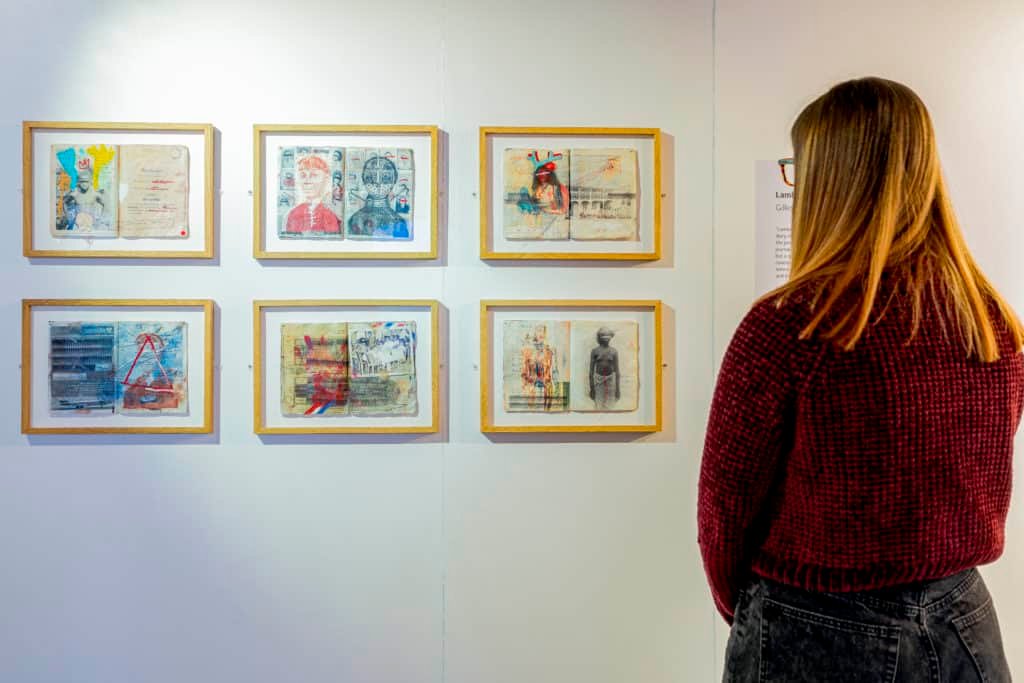International Slavery Museum (ISM) reopened to the public on Tuesday 18 May, with two new displays – both being powerful, relevant, and thought-provoking art works.
Contributions by Shane D’Allessandro, a striking painting of the Union Jack, is an ode to the Windrush generation capturing the Caribbean contribution to British Society. On display in the museum’s Legacy gallery, this painting has a personal story for Shane whose paternal grandparents were part of the Windrush generation and supported Britain during and after World War Two. This artwork serves as an expression of solidarity with them and with the entire Windrush generation who faced constant overt and institutional discrimination.
When asked why Shane wanted International Slavery Museum to house his artwork he commented: “I wanted it to be in a venue that would really understand what the painting is trying to convey, and the weight of that message. I want visitors to interact with the painting and come away with a deeper understanding of the impact this generation had to British life.”

The Legacy gallery exists as a reminder of the racism and discrimination faced by the Black population even after the abolition of the slave trade. This section of the museum also demonstrates the unquenchable spirit of people of African descent, which has helped to shape society and cultures around the world. The significance of Black achievement, resilience and contribution to society is eternal, and International Slavery Museum is proud to celebrate and honour those who have drastically changed the course of history to educate and empower others.
Another addition to the museum walls is Lambeaux (scraps) by Gilles Eli-Dit-Cosaque which is a fantasised diary, reconstructed from disparate elements. A moving journal, filled with personal and historical photographs, it’s also a Creole diary – not in a geographical sense, but rather a state of mind, referring to the concept of creolisation. The fragmented pages are a work of art constantly on the move, like the experience of memory.
Employing the trope of notetaking as its form, the Lambeaux aestheticises the labour that happens before a project is finished. Each piece is a 2-page spread from a notebook with a binding fold in the middle. Gilles’ art is very much alive, allowing for fluidity and multiple points of view.
Lambeaux is part of the Challenging histories exhibition at ISM; a section of the museum that features contemporary artworks responding to the history of transatlantic slavery and its legacy. In 2014, the museum received a generous grant from the National Lottery Heritage Fund’s Collecting Cultures programme – allowing ISM to develop its own collections. Lambeaux was its most recent acquisition, with an already impressive collection of 40 objects, documents, and artistic works.
Head of International Slavery Museum Dr Richard Benjamin comments: “It’s been a long few months for everyone and we are just so pleased that we can finally reopen our doors to visitors once again. These two new artworks provide an important voice and perspective; creating a richer and more powerful way for our visitors to engage, interact and learn about this history and its legacies.
“We’re an active museum and we make subjective decisions about what we want to get involved in and the work we do. It’s so great to have Shane’s and Gilles’ artwork on our walls and we look forward to sharing this with our visitors.”
Open Tuesday – Sunday 10am–6pm (free entry but pre booking essential). Closed Mondays except bank holidays. To book tickets: www.liverpoolmuseums.org.uk/visit
Image Gary W Smith










